Maintaining Success
The genius of Gail Goestenkors didn't lie with her use of a particular
system or style of play, though in theory she favored hard-nosed defense
and a running offense if possible. What made her such an effective coach,
year after year, was her ability to take whatever talent she had and find
a system that worked for them. Nowhere was that in greater evidence than
with her 2000 club, one of my favorites. Though that team lost six
seniors, including the program's first Kodak All-American in Michele Van
Gorp and the program's all-time assist leader in Hilary Howard, the 2000
team stunned everyone by winning 28 games, the program's first ACC
Tournament championship, and making it to the Sweet Sixteen.
It didn't come as a huge shock to me that Duke was able to do this,
because the holdovers from the '99 team were the players who did all the
dirty work: offensive rebounds, sticky on-ball defense, prescient off-ball
defense, setting screens and playing without ego. The fact that Duke was
able to win so many games without a single rotation player over 6-1 could
be attributed to Coach G employing 5-out motion to take advantage of her
team's ability to pass and shoot. Their ability to defend so well was
thanks to the athletic and tenacious forward tandem of Rochelle Parent and
Peppi Browne. With Browne in the lineup, Duke could take on anyone.
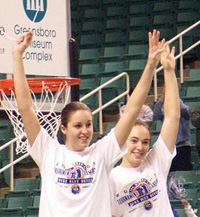 But when Peppi went
down with a career-ending knee injury, the team buckled for a couple of
games but regrouped to nip UNC in one of the most exciting championship
games in ACC history. When Browne went out, the team turned to the stoic
Georgia Schweitzer to lead the way, and her toughness and clutch play got
her tabbed as just the program's second ACC player of the year, and first
under Gail. In many respects, that team had to be one of the most fun for
Gail to coach, because everyone knew and stuck to their role. That was
the last year that one of her freshman classes didn't have a big-time star
in it, though both Sheana Mosch and Michele Matyasovsky were very
good players. Gail could just coach and didn't have to worry about massaging
egos. That would change the next season. But when Peppi went
down with a career-ending knee injury, the team buckled for a couple of
games but regrouped to nip UNC in one of the most exciting championship
games in ACC history. When Browne went out, the team turned to the stoic
Georgia Schweitzer to lead the way, and her toughness and clutch play got
her tabbed as just the program's second ACC player of the year, and first
under Gail. In many respects, that team had to be one of the most fun for
Gail to coach, because everyone knew and stuck to their role. That was
the last year that one of her freshman classes didn't have a big-time star
in it, though both Sheana Mosch and Michele Matyasovsky were very
good players. Gail could just coach and didn't have to worry about massaging
egos. That would change the next season.
The 2001 team broke a school record by winning 30 games and
introduced the greatness of Alana Beard to the world. The fact that the
ultra-talented Beard meshed so well with the toughness of senior leader
Schweitzer was a credit to them both. It's not surprising that they were
closer to Coach G than any other player. Gail let it be known that she
was tough on her players but that she also cared about them, but that
tough love didn't always make her a beloved figure. Part of that was
because Gail was always hardest on the players who didn't want to win as
badly as she did and weren't willing to devote everything to basketball.
In Beard & Schweitzer, she saw mirror images of herself, two players who
invested everything in winning. Gail let them do what they wanted on the
court because she knew they were on the same page, but she kept most of
the other players on a much tighter leash--and that chafed many of them.
Gail has never been ambiguous in talking about how roles were
determined at Duke. At the beginning of the year, she thoroughly
evaluates each player's progress and lets them know what their current
role is, and precisely what would need to change for that role to expand.
Some players do break through by working on their weaknesses while others
don't. The 2001 team, with the astonishingly capable 5-woman frosh
class, was perhaps the least-enjoyable 30-win team to watch at times and
certainly couldn't have been easy to coach. Some veterans groused when
their minutes were cut, and Gail for the first time encountered a sense of
entitlement from some of her players. There was a lot of resentment
between some of the members of the frosh and soph classes, and even some
weird off-court conflicts between members of the soph class.
With Beard, Schweitzer and defensive ace Parent around, Duke didn't
need great chemistry. They stormed through the ACC with a 13-3 record and
dominated NC State for the ACC tournament title. Of course, this
still-young group nearly blew it in the first round against bottom-feeder
Wake Forest, but Schweitzer rescued them single-handedly. They were
rewarded with their first #1 seed in the NCAA tournament, but the team
disintegrated in the Sweet Sixteen against Jacki Stiles and Southwest
Missouri State.
After that season came a lot of house-cleaning. Two sophomores
transferred, one of which had burned her bridges with Coach G much earlier
in the season and another of which knew that she was never going to get
any playing time. Another sophomore who had battled injuries for most of
her career was told that she wasn't likely to get any playing time either,
so she chose to stay at Duke but leave the basketball team, later joining
the Duke Tennis squad. That left a lean roster of 10 for the coming
season.
Of course, the 2002 roster was trimmed to 8 just a few games
into the season. Soph Rometra Craig cited homesickness and transferred to
Southern Cal, but the presence of superfrosh Monique Currie couldn't have
helped matters any. Soph Crystal White, at almost exactly the same time,
decided to transfer to LSU; no reason was ever given, but frosh Wynter
Whitley starting might have influenced that as well. Then came the
biggest shock: Joanne Boyle was struck down with an arteriovenous
malformation, essentially a blood clot in her brain. Her surgery was
successful, but it was touch and go. Down an assistant, Gail turned to
Schweitzer (starting med school) to help out, and Georgia met the
challenge. Having an assistant who knew what the players were going
through proved to be a huge help during a time when Boyle--an assistant
that every player felt close to--was ailing. The tension on the team
before the transfers could be felt as Duke was stunned on the road by
Toledo and was upset in their own Classic by South Carolina.
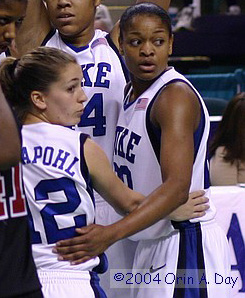
Though the team had just 8 players, Gail circled the wagons and made an
interesting tactical move: she installed little-used soph Vicki Kraphol as the
starting point guard. That freed up Alana Beard to hunt her own shots instead
of playing out of position at point. It also established a great working
relationship between Vicki & Alana, symbolized by Vicki jumping up
high to high-five Alana's outstretched hand before each game. Working
once again with
5-out motion (to take advantage of Iciss Tillis' mobility and shooting), Duke
blitzed the ACC with a perfect 16-0 record and edged their way to their 3rd
straight ACC Tournament title. The Devils took care of business in the first
two rounds of the NCAA tournament and then had the advantage of playing in
Raleigh for the regional final. They got payback against South Carolina in the
regional final and made it to the program's second Final Four They ran out of
gas against Oklahoma in the national semi's, but Gail got everything out of
this team that was possible. The fact that Gail was bringing in another
top-notch recruiting class the next season, with virtually every top player
returning made Duke one of the teams to beat heading into the 2003
season.
Indeed, the 2003 squad was a mighty one, with a best ever 35-2
mark. This included the program's first preseason #1 ranking and an early
beat-down of Tennessee in Raleigh. The team won their first 20 games of
the year (another record) before hosting UConn in Cameron, the program's
first-ever sellout. Duke was not ready to match the Huskies' focus, and
the Devils lost after a furious rally. One of the results of that game
was installing a certain Lindsey Harding as a starter, making the team
quicker and tougher on defense. The team didn't lose again until the Final
Four in Atlanta, when everyone but Beard froze up. Duke went 16-0 for
the second straight season in the ACC, and once again breezed to the ACC
title, defeating UNC for the crown for the third time. Gail picked up her
second consecutive ACC coach of the year award and was also the consensus
national coach of the year.
For the first time, Gail signed the #1 recruit in the country to Duke
that year, Brittany Hunter. Along with her came another Ohioan, Alison
Bales. Hunter was the big, aggressive and mobile low-post player that Gail
had always coveted. In 2004 for the first time, Gail had
everything she needed to win the national title that obsessed her (and
Beard) so much. She had depth, shooting, size (Hunter & Mistie Bass were
a bruising combo) and experience. To top it all off, Monique Currie was
set to return from knee surgery.

Yet despite that team's success, it wasn't a well-oiled machine.
Hunter hurt her knee early in the year and never fully recovered. Not
getting in crucial practice minutes made it a mystery from game-to-game if
she could fit in with what the rest of the team was doing. Tillis was
mired in a season-long offensive slump. Currie deferred too much to older
teammates and didn't always play with intensity. Duke's sheer talent
carried them to another dominant ACC season, but not without an upset loss
to FSU, played without Tillis, ending a huge ACC winning streak.
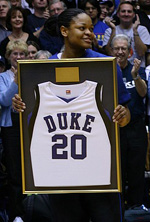 The Devils sold
out another game in Cameron on the day that Beard's jersey was retired -
yet another program first, unfortunately for deserving players like
Schweitzer and Chris Moreland (a slight that we hope to further address).
Sadly, the sellout was spoiled by another loss,this time to Tennessee, but
the Devils bounced back to defeat UNC two more times - and the 12th
straight victory over the Heels gave Duke their 5th straight ACC title.
Depite that, the year's true highlight was their monumental comeback win
against UConn, with Jessica Foley hitting a buzzer-beating three on a pass
from Harding. This win and the Tennessee win in '99 remain Gail's two
most memorable victories.
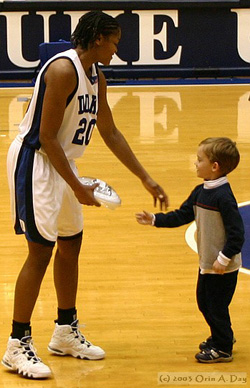
Duke was in nearby Norfolk for the regional final, and Duke nipped a
tough Louisiana Tech team to advance to the Elite Eight. The pressure
surrounding Beard and Coach G proved too much for them in that matchup
against Minnesota. Everyone was devastated for Alana that she couldn't
compete for the national title that had eluded her, but the experience
changed Gail. Beard was unquestionably the greatest player in program
history, smashing a multitude of records. But more than her sheer
statistical impact was her presence: she drew in many new fans, was an
extraordinary ambassador for the university and was great with children in
particular. She was as playful and friendly off the court as she was
intense and business-like on it. In some ways, she was almost too good a
player: the team often got caught up in watching her play and depended on
her to bail them out of trouble. This was in stark contrast to the great
team-first units Gail had assembled in the past.
Life (and Success) After Alana
Many of Gail's best teams came in years when no one expected Duke to be
great. Replacing the Beard-Tillis-Krapohl combo in 2005 wasn't
going to be easy, especially with Hunter deciding to transfer to UConn.
With Brooke Smith transferring to Stanford a year earlier, Gail continued
to be hit with defections by players who were either homesick or
unsatisfied with their playing time. In Hunter's case, her mother blamed
Duke for mishandling her injury, though a close look at the facts revealed
that Hunter bore as much responsibility for that situation as anyone.
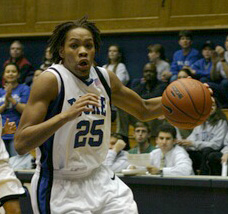 The 2005 team was dealt another early blow when Gail suspended Harding
for the year, for reasons that have never been revealed publicly. Once
again, Gail circled the wagons and built the team around Currie. Monique
carried the team that year, hitting game-winning shots and putting up huge
numbers. Bales
emerged as a tremendous defensive force, Mistie Williams (nee Bass) became a
dependable scorer, Foley hit threes and frosh Wanisha Smith did a fine job
after being pressed into playing point. The season's highlight was an upset
win over Tennessee on the road, as the Devils became one of a very tiny subset
of teams that has beaten both UConn and Tennessee at home.
The 2005 team was dealt another early blow when Gail suspended Harding
for the year, for reasons that have never been revealed publicly. Once
again, Gail circled the wagons and built the team around Currie. Monique
carried the team that year, hitting game-winning shots and putting up huge
numbers. Bales
emerged as a tremendous defensive force, Mistie Williams (nee Bass) became a
dependable scorer, Foley hit threes and frosh Wanisha Smith did a fine job
after being pressed into playing point. The season's highlight was an upset
win over Tennessee on the road, as the Devils became one of a very tiny subset
of teams that has beaten both UConn and Tennessee at home.
Duke tied for first place in the ACC but finally lost in the
tournament, dropping their 3rd straight against UNC. Duke battled
injuries all year, as both Foley & Currie were slowed late in the season.
Gail just plugged Wynter Whitley into Foley's guard spot and Wynter
delivered in the NCAA tournament, as Duke surprisingly made it to the
Elite Eight yet again. This time, they were shut down by LSU, but there
was a sense that this was another team that did all it could--a much
better feeling than after the 2004 season.
I don't
need to
talk too much about the 2006 (right) and 2007 seasons--the
highs and lows are probably still fresh in everyone's minds (note that our
2007 Season Recap is slated for publication in several weeks).
Currie returned for a fifth season
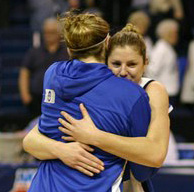 along with Harding in 2006.
They
finished out of first place in the ACC for the first time since 2000 and
didn't make the finals of the ACC tournament for the first time since
1999.
Still, they beat Tennessee in a sold-out Cameron and went on a
magic ride to the Final Four.
They beat
UConn in Bridgeport thanks to an amazing defensive performance by
regional MVP Bales, got back at LSU for their 2005 defeat, and then lost
to Maryland by the slimmest of margins. This team saw the debut of Abby
Waner, another player whose intensity matched that of Gail's and put her
in the Beard/Schweitzer category.
along with Harding in 2006.
They
finished out of first place in the ACC for the first time since 2000 and
didn't make the finals of the ACC tournament for the first time since
1999.
Still, they beat Tennessee in a sold-out Cameron and went on a
magic ride to the Final Four.
They beat
UConn in Bridgeport thanks to an amazing defensive performance by
regional MVP Bales, got back at LSU for their 2005 defeat, and then lost
to Maryland by the slimmest of margins. This team saw the debut of Abby
Waner, another player whose intensity matched that of Gail's and put her
in the Beard/Schweitzer category.
The 2007 team was certainly not the deepest or most talented in
Duke history, but the chemistry was incredible. The extent to which each
player knew their role and played it to the max reminded me of the 2000
squad--only with much more talent. They beat every ranked opponent in
their way and only faltered late in the season, and then only in the
tightest of games. Harding wound up as the national player of the year
and Gail won her 7th ACC coach of the year award and was the consensus
coach of the year as well. Harding would go on to become the program's
first #1 pick in the WNBA draft.
Trading Azaleas for Bluebonnets
Exactly what happened to cause Gail to leave Duke for Texas was in some
ways a perfect storm of events. Her recent public statement to the
contrary, there had been rumblings for quite some time that she sometimes
had to struggle to get things she needed and wanted for her program,
especially in the area of growing the fan base. While the 2007 in-stadium
promotions were noticeably improved from past years, other aspects of
marketing seemed to be lagging. Merchandise for sale at Cameron didn't
seem to have fresh designs, and was on discount most of the season.
Alumni and friends of the program pitched in with talents and dollars for
other efforts, but that's not the same thing as true institutional
support.
Texas was really the only program in the country that had a shot at
her, given Gail's long-standing admiration for Jody Conradt, the
supportive administration, the resources of the university and her
already-existing connections to Texas high school talent. It was clear
that for the first time, she saw herself as being in an environment that
was perfect for her, and she took that opportunity. It's not going to be
easy following a legend like Conradt, nor will it be easy leaving behind
what she built at Duke, but she's certainly earned a chance to rebuild the
Longhorn program.
It was Duke's misfortune that she was able to tear herself away from
the program that she built, and it was Duke's mistake that they hadn't
moved much earlier to give her a long-term contract in line with the
compensation packages of other top women's coaches. Duke does not publish
coaches salaries, but mandatory IRS filings indicated that that 5 coaches
at Duke earned a higher base salary than Gail, and that list included
non-head coaches. I only hope that the administration didn't take Gail's
winning for granted and are truly prepared to back up their public
statements, and fully support the next coach's needs to field the best
possible program.
Gail's legacy at Duke was in taking very good players and developing
them into well-rounded stars. She never cut corners on academics, with
her team always getting multiple entries on the ACC's honor roll. Many of
her players appeared on the honor roll in each of their four seasons.
Gail never accepted anything less than excellence from her players. That
sometimes put her in the role of the demanding taskmaster, but it always
meant that her teams could compete with anyone. Her last 7 teams each won
at least 30 games, a new national mark. Her teams finished in first place
8 times and won 5 ACC tourneys. She took her teams to 4 Final Fours.
The one black mark on her record was never winning it all. After the 2006
loss, Kay Yow contacted Gail, with the encouragement that the championship
was not denied, but deferred. With the results of 2007 in the books, and
the ensuing changes, only time will tell if Coach Yow's wise words of
comfort will apply to her friend Gail, or Duke, or both.
While it's possible that her obsession may have made her teams tight at
times, Gail's demeanor changed the past 2 seasons. She's more patient on
the floor, less likely to embarrass a player by screaming at them. She
was more willing to give players second chances and let them expand their
roles. It took John Wooden and Dean Smith about 20 years before they won
their first title, and many Final Fours for Pat Summitt. Once Gail breaks
that barrier--and there's a great chance she'll do that now at
Texas--she'll never look back. Duke and its supporters owe Gail
Goestenkors a tremendous debt for not only building a team, but creating a
culture, and she'll never be forgotten.
Afterword, by Orin Day
Gail's years at Duke were a great ride, and our family was privileged
to be along for so much of it. From the early years when I was largely
away from the program (including "watching" the 4OT thriller on a
text-based internet broadcast), to the 1998 breakthrough season when I
moved back to Durham, and then through these "Glory Years" of great
individual and team success, we've been thrilled by the highs and crushed
by the lows. Seeing the team fall to Tennessee at the 2003 Final Four,
and then being present for Gail's WBCA Coach of the Year acceptance speech
the next day is a moment we will forever cherish. A parade of coaching
greats in "The Green Room" speculated that Gail wouldn't show up, but when
she arrived she lit up the hall, demonstrating her true character and
commitment to the game in spite of the circumstances. I think that's when
many found out what we already knew, just how great Gail Goestenkors was.
She still is today.
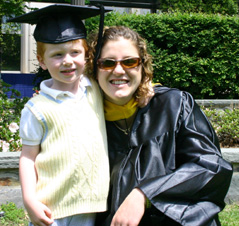
Each year, when the blooms of spring appear, we are forced to
anticipate not just another March packed with basketball and travel, but
also the ensuing May, as another set of fine young women and men depart
Durham with Duke degrees in hand. We've made many friends from the
program who we knew would leave at the end of their Duke careers, friends
like Olga and Sheana and Jess, who continue to touch our lives and
family from afar. Likewise, we will deeply miss Ali and Lindsey, and their families, wishing
them joy and success in whatever they undertake.
But now, unexpectedly, our friend Coach G is gone from Duke. While we
will always support her, and her decision to advance her career elsewhere,
our ultimate loyalties lie with Duke, and the players and staff that
remain here. In her first Texas press conference, Gail cited the
importance of relationships. We agree. This program is not bricks and
mortar or wins and losses or ticket sales or trophies, but rather the
people that comprise it. They are the ones who need our support now, and
in greater measure than before.
The wonderful thing about Duke Women's Basketball is that we all can be
involved, personally, and we all can make a difference. At the annual
banquet in a couple weeks (which we hope you will be attending), we
encourage you to thank the staff members, players, and managers for all
they have done. Tell them how much their efforts matter, and that you
share their joy, and pain. And that, once today's brilliant green leaves
turn brown and fall, that you'll be back in Cameron to start a new chapter
in the history of this program. Personally, I can't wait. Go
Devils!!!
Update: Early in
the week, before Coach G had made her decision public, the team and staff
said another emotional goodbye, bidding a fond farewell to assistant
Tia Jackson. She is the new head coach of the University of
Washington, formally announced
Friday in Seattle. Tia was a mentor and friend who will be
missed by
everybody she touched. But we're sure she'll be happy and successful
under Todd Turner, one of the finest athletic directors in the land.
She's the third Goestenkors assistant to become a Division I head coach,
joining fellow ex-Duke assistants LaVonda Wagner and Joanne Boyle in the
Pac10 Conference.
Our coverage will continue with a Coach G Photo
Gallery
This has been delayed until the end of the week...

|
